Surface–Volume Integral Formulation for Evaluating Magnetization Losses in CORC® Cables
Abstract
1. Introduction
2. Materials and Methods
2.1. Modeling Electrical Resistivity
2.2. Numerical Solution
- Define the geometry and generate the mesh for and ;
- Construct and store the time-independent matrices , , (for ), and , using a suitable data-sparse representation;
- Define the mapping for constructing the resistance matrix;
- Specify the external field excitation;
- Solve the nonlinear time-dependent problem.
Electrical Resistivity Reconstruction
2.3. Losses Calculation
3. Results
3.1. HTS Plate Above Conductive Substrate
3.2. CORC® Cable
4. Conclusions
Author Contributions
Funding
Data Availability Statement
Conflicts of Interest
References
- van der Laan, D.C.; Weiss, J.D.; McRae, D.M. Status of CORC® cables and wires for use in high-field magnets and power systems a decade after their introduction. Supercond. Sci. Technol. 2019, 32, 033001. [Google Scholar] [CrossRef]
- Zhai, Y.; van der Laan, D.; Connolly, P.; Kessel, C. Conceptual design of HTS magnets for fusion nuclear science facility. Fusion Eng. Des. 2021, 168, 112611. [Google Scholar] [CrossRef]
- Sorti, S.; Balconi, L.; Rossi, L.; Santini, C.; Statera, M. Toward Real-Time Electromagnetic Simulations of HTS Non-Insulated Coils Through Proper Orthogonal Decomposition. IEEE Trans. Appl. Supercond. 2025, 35, 4901505. [Google Scholar] [CrossRef]
- Huang, Y.; Yazdani-Asrami, M.; Song, W. A Deep Learning-Based Ultra-Fast Surrogate Model for AC Loss Estimation in Superconductors Using COMSOL. IEEE Access 2025, 13, 153845–153854. [Google Scholar] [CrossRef]
- Lucchini, F. Evaluating Magnetization Losses in 3-D CORC Tapes with Integral and Finite-Element Methods. IEEE Trans. Appl. Supercond. 2025, 35, 5901808. [Google Scholar] [CrossRef]
- Chow, C.C.T.; Grilli, F.; Chau, K.T. Numerical modelling of HTS tapes under arbitrary external field and transport current via integral method: Review and application to electrical machines. Supercond. Sci. Technol. 2023, 36, 115027. [Google Scholar] [CrossRef]
- Lai, L.; Gu, C. AC loss calculation in REBCO coils or stacks by solving the equation of motion for current using an integration approach. Supercond. Sci. Technol. 2020, 34, 015003. [Google Scholar] [CrossRef]
- Anvar, V.A.; Ilin, K.; Yagotintsev, K.A.; Monachan, B.; Ashok, K.B.; Kortman, B.A.; Pellen, B.; Haugan, T.J.; Weiss, J.D.; van der Laan, D.C.; et al. Bending of CORC® cables and wires: Finite element parametric study and experimental validation. Supercond. Sci. Technol. 2018, 31, 115006. [Google Scholar] [CrossRef]
- Zhang, Y.; He, J.; Chen, T.; Wang, J.; Du, G. Study on Loss and Thermal Properties of a Superconducting Pancake Coil under Self-Field and Analysis of Its Influencing Factors. Crystals 2022, 12, 1314. [Google Scholar] [CrossRef]
- Tian, M.; Yang, J.; Shen, B.; Öztürk, Y.; Ma, J.; Li, C.; Shah, A.; Patel, I.; Li, J.; Coombs, T. Magnetization Loss Characteristics in Superconducting Conductor on Round Core Cables with a Copper Former. IEEE Trans. Appl. Supercond. 2021, 31, 4803204. [Google Scholar] [CrossRef]
- Shen, B.; Chen, X.; Fu, L.; Zhang, M.; Chen, Y.; Sheng, J.; Huang, Z.; Wang, W.; Zhai, Y.; Yuan, Y.; et al. A Simplified Model of the Field Dependence for HTS Conductor on Round Core (CORC) Cables. IEEE Trans. Appl. Supercond. 2021, 31, 4803405. [Google Scholar] [CrossRef]
- Yang, J.; Li, C.; Tian, M.; Liu, S.; Shen, B.; Hao, L.; Ozturk, Y.; Coombs, T. Analysis of AC transport loss in conductor on round core cables. J. Supercond. Nov. Magn. 2022, 35, 57–63. [Google Scholar] [CrossRef]
- Wang, Y.; Zhang, M.; Grilli, F.; Zhu, Z.; Yuan, W. Study of the magnetization loss of CORC® cables using a 3D T-A formulation. Supercond. Sci. Technol. 2019, 32, 025003. [Google Scholar] [CrossRef]
- Li, Y.; Marek, D.; Triverio, P. MultiAIM: Fast Electromagnetic Analysis of Multiscale Structures Using Boundary Element Methods. IEEE Trans. Antennas Propag. 2024, 72, 5877–5891. [Google Scholar] [CrossRef]
- Bettini, P.; Passarotto, M.; Specogna, R. Coupling Volume and Surface Integral Formulations for Eddy-Current Problems on General Meshes. IEEE Trans. Magn. 2018, 54, 7203604. [Google Scholar] [CrossRef]
- Frescura, A.; Bettini, P. Hierarchical matrices accelerated large-scale eddy current problems with coupled volume and surface integral equations. J. Phys. Conf. Ser. 2025, 3027, 012005. [Google Scholar] [CrossRef]
- Gömöry, F.; Šouc, J.; Solovyov, M.; Ries, R.; Hintze, C.; Landvogt, S.; Pekarčíková, M.; Christensen, J.J.; Bahl, C.R.H.; Jørgensen, N.O.; et al. Hysteresis and Coupling Loss in Filamentized REBCO Tapes. IEEE Trans. Appl. Supercond. 2025, 35, 5900205. [Google Scholar] [CrossRef]
- Zappatore, A.; De Marzi, G.; Uglietti, D. Impact of Hysteresis Losses in Hybrid (HTS-LTS) Coils for Fusion Applications. IEEE Access 2023, 11, 100465–100478. [Google Scholar] [CrossRef]
- Shen, B.; Grilli, F.; Coombs, T. Review of the AC loss computation for HTS using H formulation. Supercond. Sci. Technol. 2020, 33, 033002. [Google Scholar] [CrossRef]
- Benkel, T.; Lyly, M.; Ruuskanen, J.; Halbach, A.; Lahtinen, V.; Riva, N. Modelling of a Large-Scale Non-Insulated Non-Planar HTS Stellarator Coil Using Quanscient Allsolve. IEEE Trans. Appl. Supercond. 2025, 35, 4202505. [Google Scholar] [CrossRef]
- Lucchini, F.; Torchio, R.; Morandi, A.; Dughiero, F. A Fast Integral Equation J − φ Formulation for Superconducting Structures. IEEE Trans. Appl. Supercond. 2024, 34, 5901808. [Google Scholar] [CrossRef]
- Sirois, F.; Grilli, F.; Morandi, A. Comparison of Constitutive Laws for Modeling High-Temperature Superconductors. IEEE Trans. Appl. Supercond. 2019, 29, 8000110. [Google Scholar] [CrossRef]
- Nibbio, N.; Stavrev, S.; Dutoit, B. Finite element method simulation of AC loss in HTS tapes with B-dependent E-J power law. IEEE Trans. Appl. Supercond. 2001, 11, 2631–2634. [Google Scholar] [CrossRef]
- Grilli, F.; Sirois, F.; Zermeño, V.M.R.; Vojenčiak, M. Self-Consistent Modeling of the Ic of HTS Devices: How Accurate do Models Really Need to Be? IEEE Trans. Appl. Supercond. 2014, 24, 8000508. [Google Scholar] [CrossRef]
- Viarengo, S.; Freschi, F.; Savoldi, L. CORC Cables: Numerical Characterization of the Critical Current After Bending. IEEE Trans. Appl. Supercond. 2024, 34, 4801605. [Google Scholar] [CrossRef]
- Li, X.; Ren, L.; Xu, Y.; Shi, J.; Chen, X.; Chen, G.; Tang, Y.; Li, J. Calculation of CORC Cable Loss Using a Coupled Electromagnetic-Thermal T-A Formulation Model. IEEE Trans. Appl. Supercond. 2021, 31, 4802707. [Google Scholar] [CrossRef]
- Yan, J.; Gao, Y. Mechanical and electromagnetic properties of CORC cables under combined loads of axial tension and transverse compression. Cryogenics 2025, 147, 104045. [Google Scholar] [CrossRef]
- Xia, T.; Gan, H.; Wei, M.; Chew, W.C.; Braunisch, H.; Qian, Z.; Aygün, K.; Aydiner, A. An Enhanced Augmented Electric-Field Integral Equation Formulation for Dielectric Objects. IEEE Trans. Antennas Propag. 2016, 64, 2339–2347. [Google Scholar] [CrossRef]
- Bettini, P.; Passarotto, M.; Specogna, R. A Volume Integral Formulation for Solving Eddy Current Problems on Polyhedral Meshes. IEEE Trans. Magn. 2017, 53, 7204904. [Google Scholar] [CrossRef]
- Börm, S.; Grasedyck, L.; Hackbusch, W. Introduction to hierarchical matrices with applications. Eng. Anal. Bound. Elem. 2003, 27, 405–422. [Google Scholar] [CrossRef]
- Torchio, R.; Lucchini, F.; Schanen, J.L.; Chadebec, O.; Meunier, G. FFT-PEEC: A Fast Tool From CAD to Power Electronics Simulations. IEEE Trans. Power Electron. 2022, 37, 700–713. [Google Scholar] [CrossRef]
- Stüben, K. A review of algebraic multigrid. In Numerical Analysis: Historical Developments in the 20th Century; Brezinski, C., Wuytack, L., Eds.; Elsevier: Amsterdam, The Netherlands, 2001; pp. 331–359. [Google Scholar] [CrossRef]
- Pouransari, H.; Coulier, P.; Darve, E. Fast Hierarchical Solvers For Sparse Matrices Using Extended Sparsification and Low-Rank Approximation. SIAM J. Sci. Comput. 2017, 39, A797–A830. [Google Scholar] [CrossRef]
- Wang, Y.; Jing, Z. Multiscale modelling and numerical homogenization of the coupled multiphysical behaviors of high-field high temperature superconducting magnets. Compos. Struct. 2023, 313, 116863. [Google Scholar] [CrossRef]
- Lucchini, F.; Frescura, A.; Torchio, R.; Alotto, P.; Bettini, P. Reduced order modeling for real-time monitoring of structural displacements due to electromagnetic forces in large scale tokamaks. Plasma Phys. Control. Fusion 2024, 66, 115002. [Google Scholar] [CrossRef]
- Fabbri, M. Magnetic Flux Density and Vector Potential of Uniform Polyhedral Sources. IEEE Trans. Magn. 2008, 44, 32–36. [Google Scholar] [CrossRef]
- Bykovsky, N.; Uglietti, D.; Wesche, R.; Bruzzone, P. AC Loss in HTS Fusion Cables: Measurements, Modeling, and Scaling Laws. IEEE Trans. Appl. Supercond. 2018, 28, 5900305. [Google Scholar] [CrossRef]
- HTS Modeling Workgroup. Benchmark #2. Available online: https://htsmodelling.com/ (accessed on 25 August 2025).
- Viarengo, S.; Brouwer, L.; Ferracin, P.; Freschi, F.; Riva, N.; Savoldi, L.; Wang, X. A New Coupled Electrodynamic T − A and Thermal Model for the Critical Current Characterization of High-Temperature Superconducting Tapes and Cables. IEEE Access 2023, 11, 107548–107561. [Google Scholar] [CrossRef]
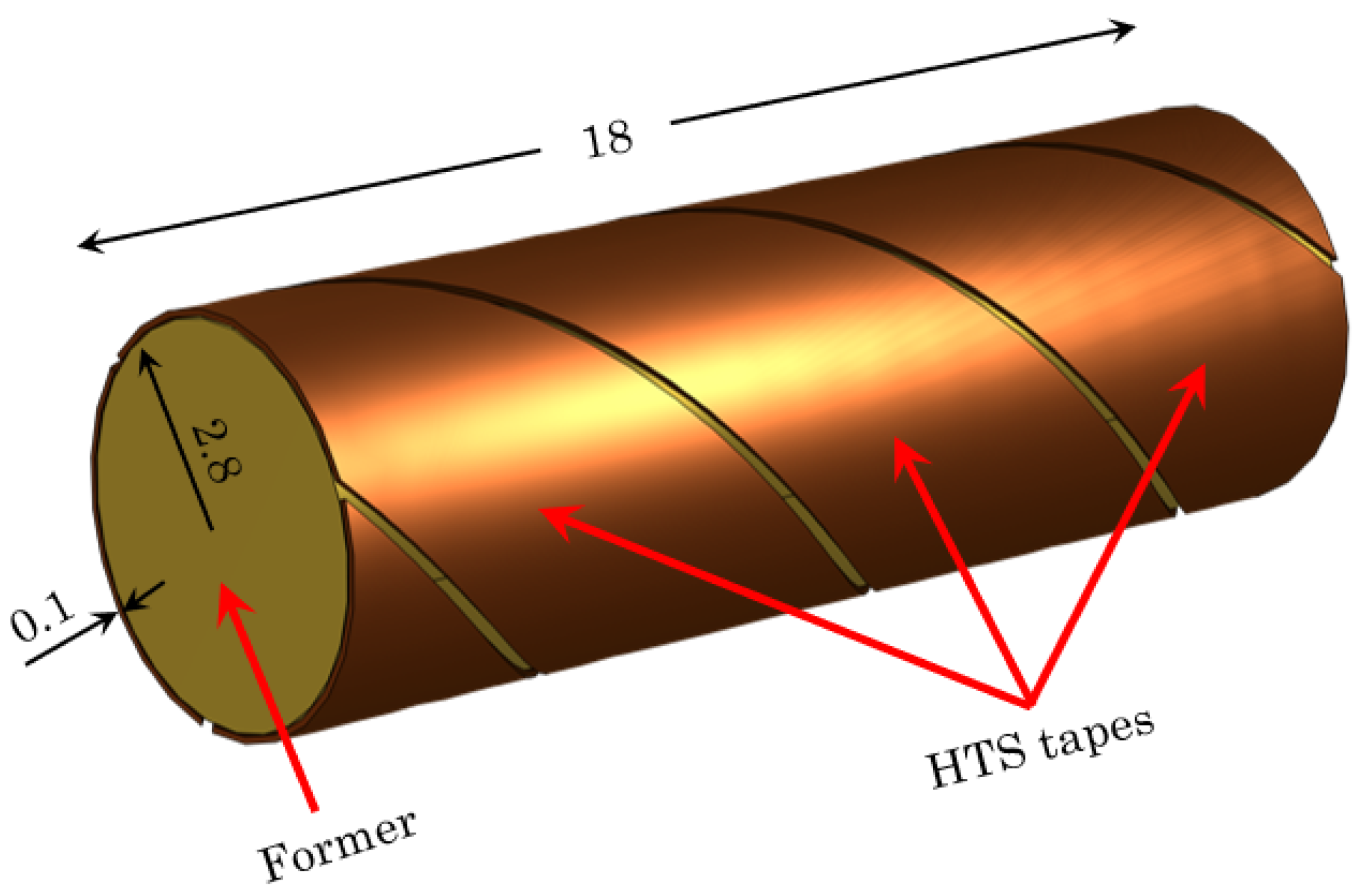
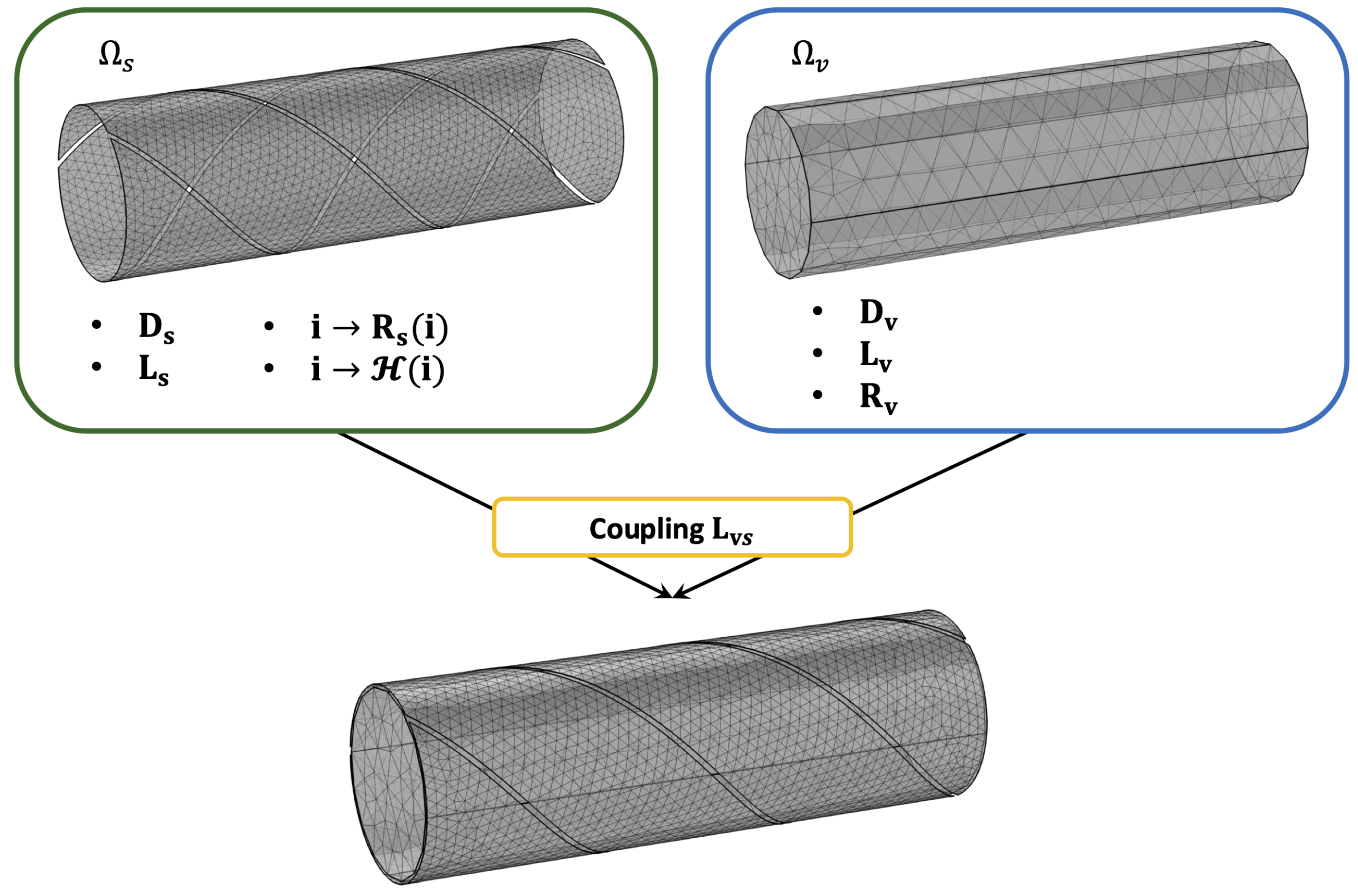
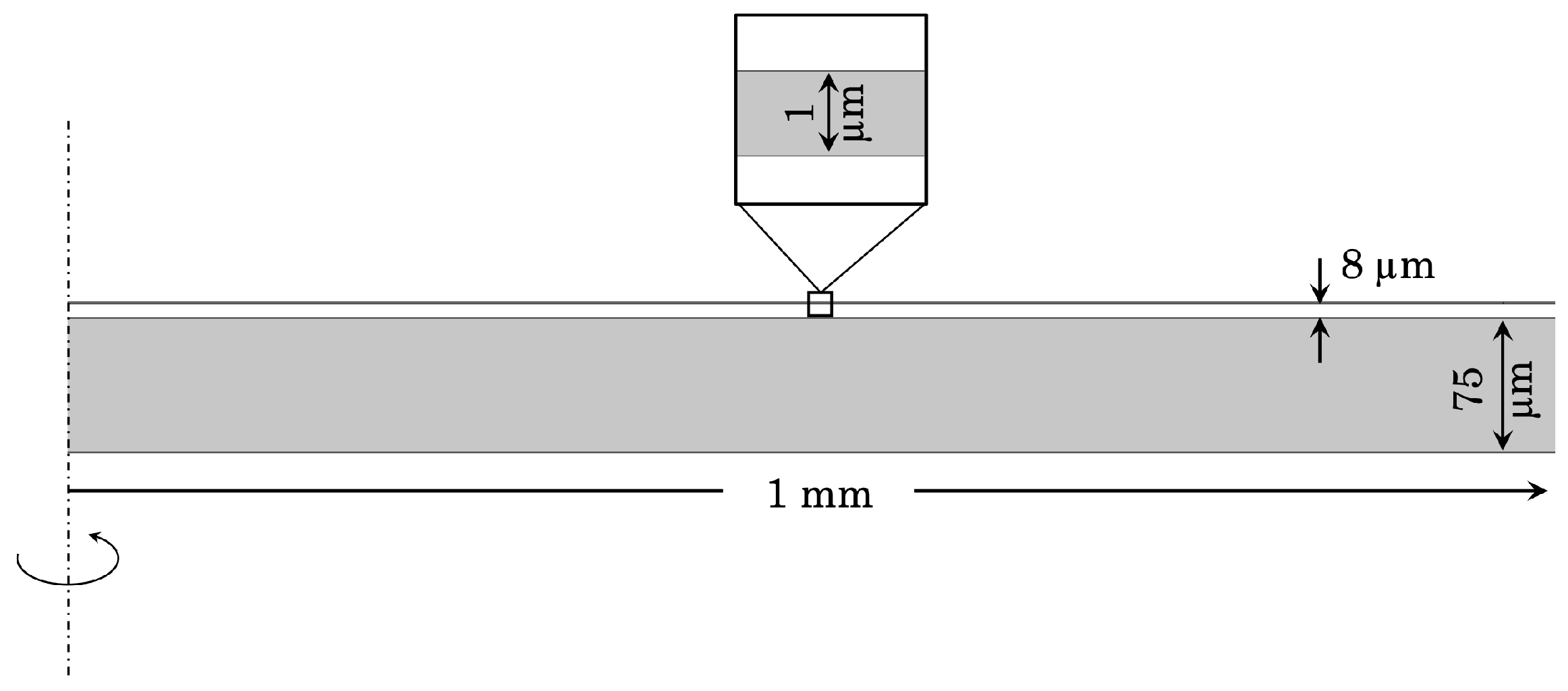
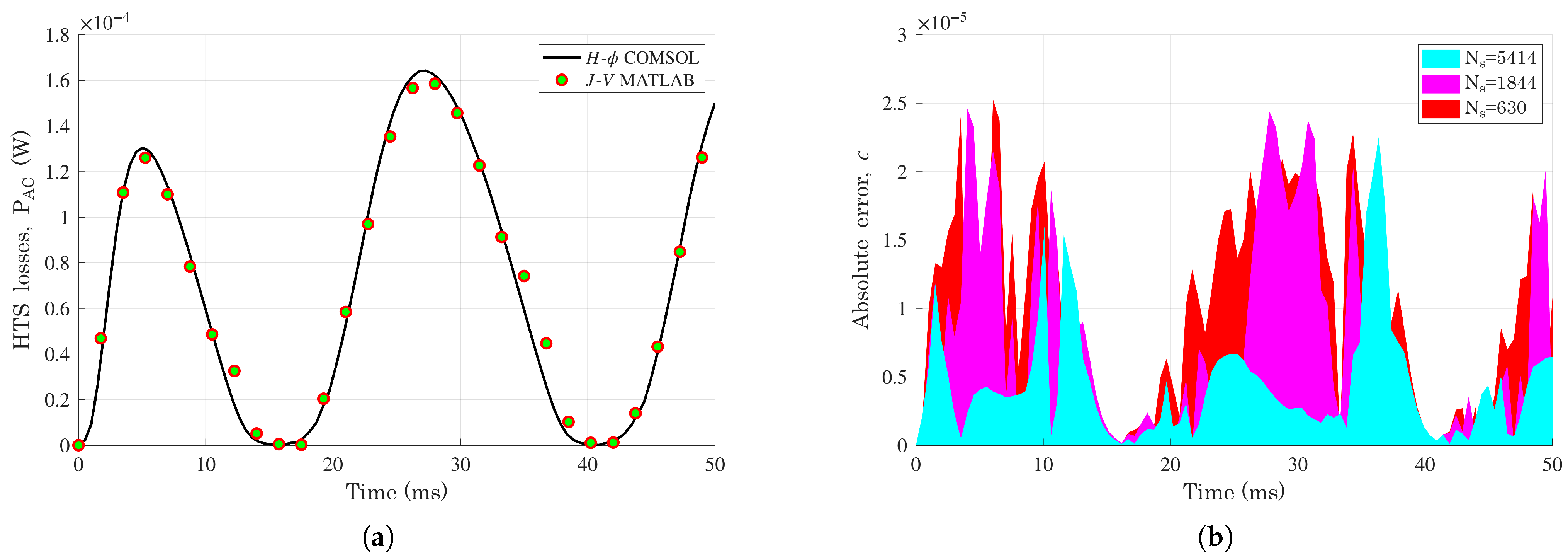
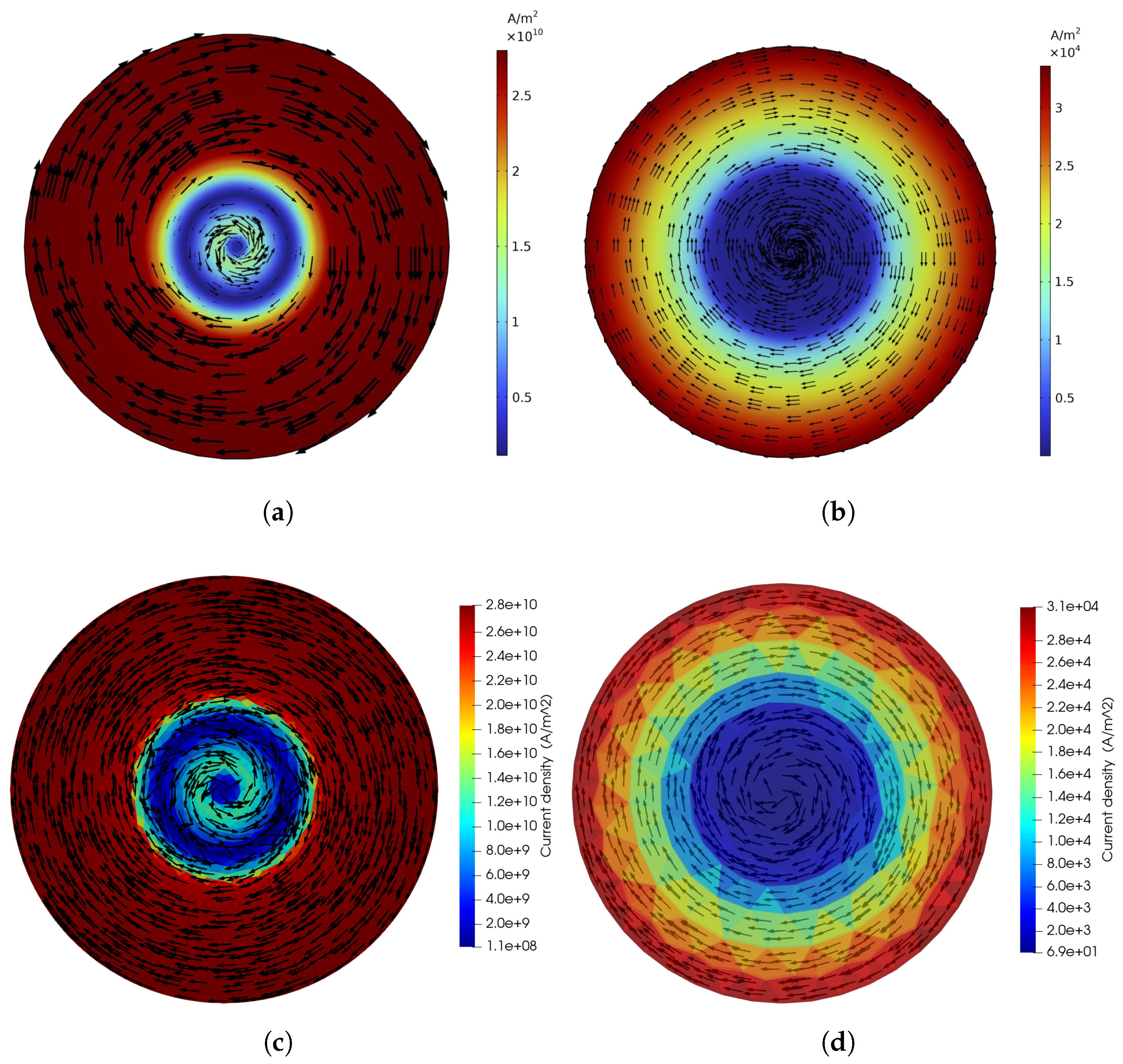
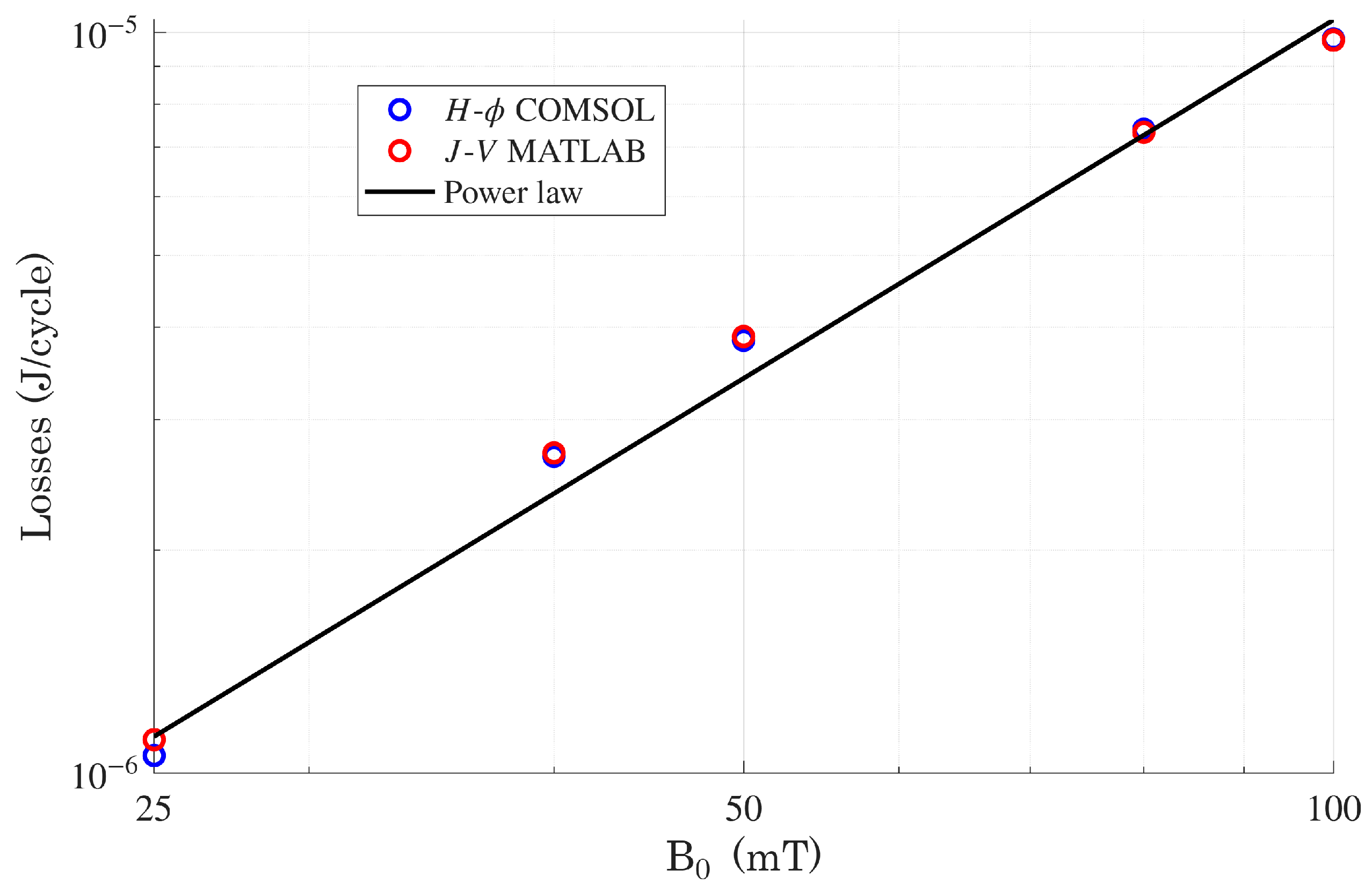
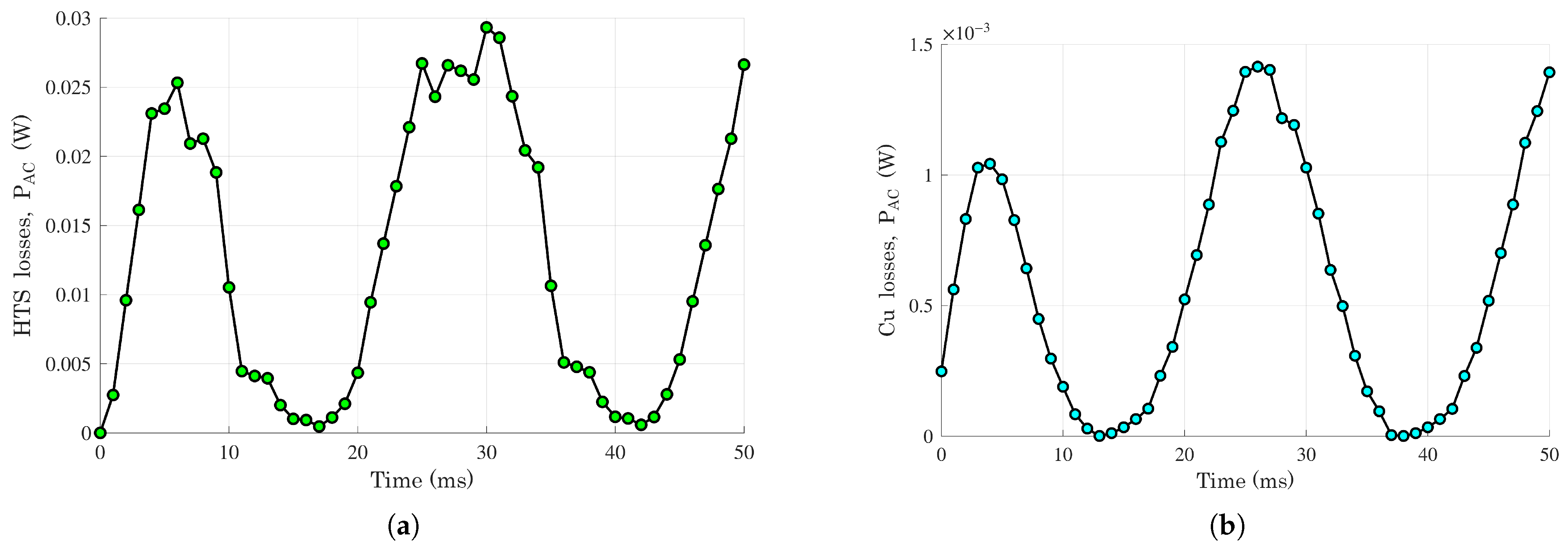
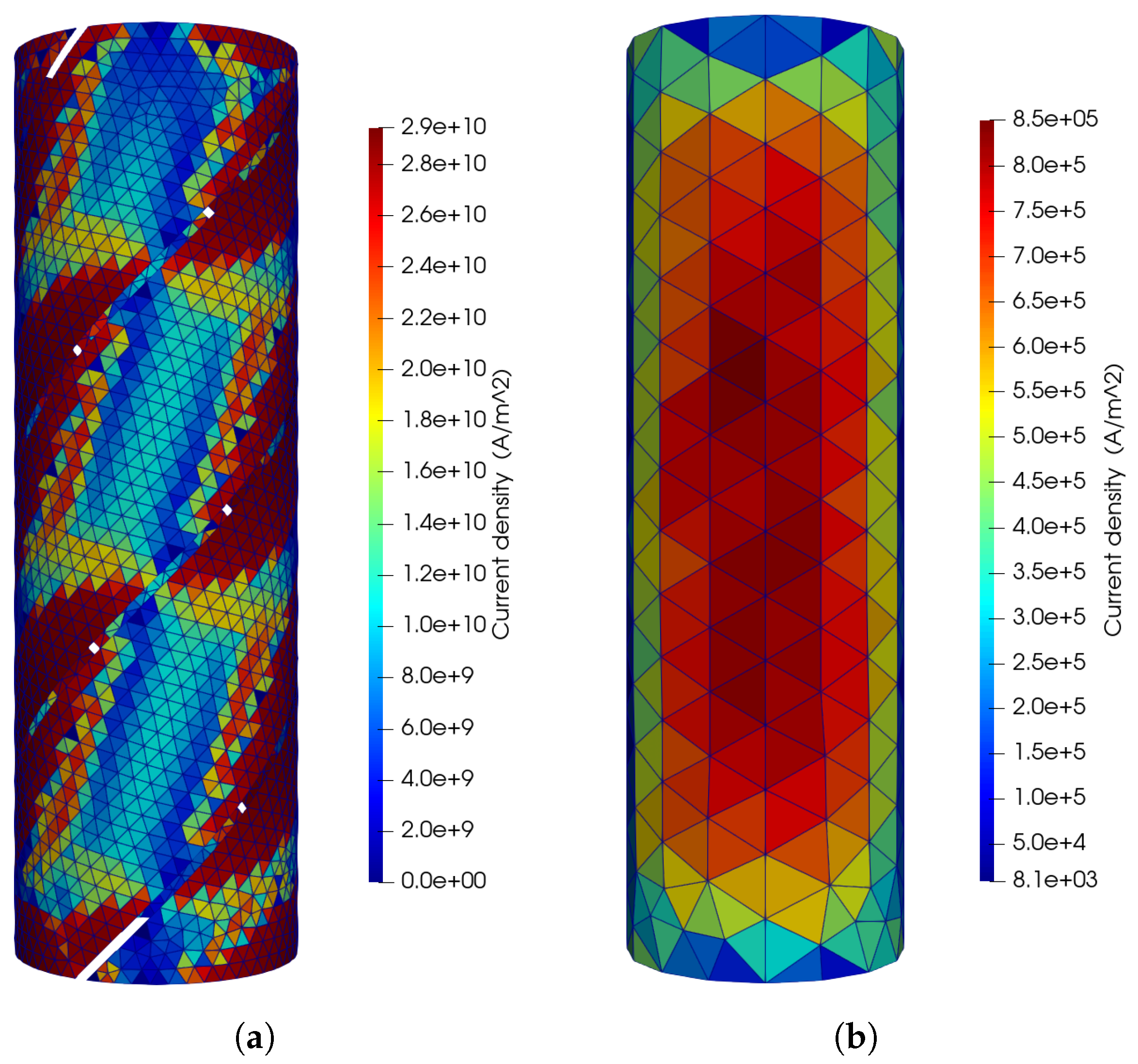
| Discretization | RMSE |
|---|---|
| Task | Time |
|---|---|
| Evaluation of , , | 3.2 s |
| Evaluation of , , | 3.1 s |
| Evaluation of | 4.7 s |
| Time integration | 1 days, 9 h |
Disclaimer/Publisher’s Note: The statements, opinions and data contained in all publications are solely those of the individual author(s) and contributor(s) and not of MDPI and/or the editor(s). MDPI and/or the editor(s) disclaim responsibility for any injury to people or property resulting from any ideas, methods, instructions or products referred to in the content. |
© 2025 by the authors. Licensee MDPI, Basel, Switzerland. This article is an open access article distributed under the terms and conditions of the Creative Commons Attribution (CC BY) license (https://creativecommons.org/licenses/by/4.0/).
Share and Cite
Lucchini, F.; Dughiero, F. Surface–Volume Integral Formulation for Evaluating Magnetization Losses in CORC® Cables. Crystals 2025, 15, 879. https://doi.org/10.3390/cryst15100879
Lucchini F, Dughiero F. Surface–Volume Integral Formulation for Evaluating Magnetization Losses in CORC® Cables. Crystals. 2025; 15(10):879. https://doi.org/10.3390/cryst15100879
Chicago/Turabian StyleLucchini, Francesco, and Fabrizio Dughiero. 2025. "Surface–Volume Integral Formulation for Evaluating Magnetization Losses in CORC® Cables" Crystals 15, no. 10: 879. https://doi.org/10.3390/cryst15100879
APA StyleLucchini, F., & Dughiero, F. (2025). Surface–Volume Integral Formulation for Evaluating Magnetization Losses in CORC® Cables. Crystals, 15(10), 879. https://doi.org/10.3390/cryst15100879







